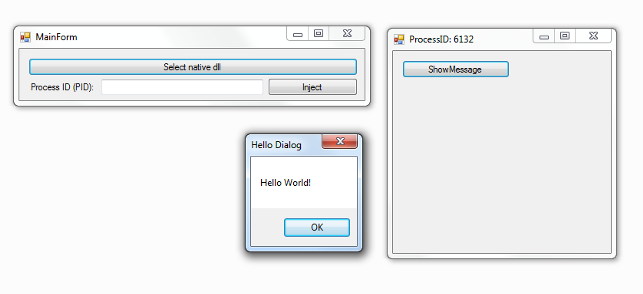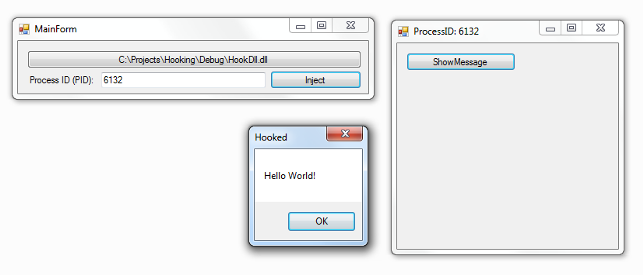Setting up Hook on Windows messages
I am trying to make an application which will notify current playing track’s name and artist to the user for that I need to monitor the track change event .
I used Winspector and found out that whenever there is a track change in spotify WM_SETTEXT message is send.
For this I believe I have to set up a HOOK through my application to look for WM_SETTEXT message sent by the other application.
Now, the problem I am facing is I am not able to get any working sample code to work with. I read the documentation of setwindowshookex and also did some googling but am really lost as I have no background of C# and handling windows messages/events.
So, If you guys can provide me a small working code to wrap my head around setting up hook on another application or if you can direct me to some nice article on how to achieve this.
3 Answers 3
Here’s a different approach: skip the SetWindowsHook API, and instead use WinEvents, which use SetWinEventHook instead. These are somewhat similar to the windows hooks, in that both involve a callback function that is called at specific events, but WinEvents are far easier to use from C#: you can specific that WinEvents are delivered «out context», meaning the events are posted back to your own process, so you don’t need a separate DLL. (Your code does need to run a message loop on the same thread that called SetWinEventHook, however.)
It turns out that one of the type of events that WinEvent supports is a ‘name change’ event, which is automatically fired by USER32 whenever the title text of a HWND changes, which seems is what you are looking for. (WinEvents can also be used to track focus changes and various types of state changes; see MSDN for more information.) It’s also fired by other controls when their internal UI changes — eg by a listbox when the text of a list item changes, so we have to do some filtering.
Here’s some sample code that prints out title changes on any HWND on the desktop — you’ll see it print out a notification as the text in the clock on the taskbar changes, for example. You’ll want to modify this code to filter for just the HWND you’re tracking in Spotify. Also, this code listens to name changes on all processes/threads; you should get the threadID from the target HWND using GetWindowThreadProcessId and only listen to events from that thread.
Note also that this is something of a fragile approach; if Spotify changes how it displays the text, or changes the format of it, you’ll need to modify your code to keep up with its changes.
Windows hook: просто о сложном

Что такое хук функций и для чего он нужен? В переводе с английского «hook» — ловушка. Поэтому о назначении хуков функции в Windows можно догадаться — это ловушка для функции. Иными словами, мы ловим функцию и берем управление на себя. После этого определения нам открываются заманчивые перспективы: мы можем перехватить вызов любой функции, подменить код на свой, тем самым изменив поведение любой программы на то, которое нам нужно (конечно, в рамках определенных ограничений).
Целью данной статьи является демонстрация установки хука и его непосредственная реализация.
— Нельзя поверить в невозможное!
— Просто у тебя мало опыта, – заметила Королева. – В твоем возрасте я уделяла этому полчаса каждый день! В иные дни я успевала поверить в десяток невозможностей до завтрака!
Где мне реально пригодились эти знания
Эти знания являются очень узкоспециализированными, и в повседневной практике разработки маловероятно, что они пригодятся, но знать о них, на мой взгляд, крайне желательно, даже если эти знания чисто теоретические. На моей практики же мне пригодились эти знания для решения следующих задач:
• Контроль входящего http-траффика и подмена «взрослого» контента на более безобидный.
• Логирование информации в случае копирования каких-либо файлов с подконтрольной сетевой папки.
• Незначительная модификация кода в проекте, от которого были утеряны исходники (да, и такое тоже случается)
Методы установки хуков
Давайте перейдем от общих фраз к более детальному рассмотрению хуков. Мне известно несколько разновидностей реализации хука:
● Использование функции SetWindowsHookEx. Это весьма простой, оттого и ограниченный, метод. Он позволяет перехватывать только определенные функции, в основном связанные с окном (например, перехват событий, которые получает окно, щелчков мышкой, клавиатурного ввода). Достоинством этого метода является возможность установки глобальных хуков (например, сразу на все приложениях перехватывать клавиатурный ввод).
● Использование подмены адресов в разделе импорта DLL. Суть метода заключается в том, что любой модуль имеет раздел импорта, в котором перечислены все используемые в нем другие модули, а также адреса в памяти для экспортируемых этим модулем функций. Нужно подменить адрес в этом модуле на свой и управление будет передано по указанному адресу.
● Использование ключа реестра HKEY_LOCAL_MACHINE\Software\Microsoft\Windows NT\CurrentVersion\Windows\AppInit_Dlls. В нем необходимо прописать путь к DLL, но сделать это могут только пользователи с правами администратора. Этот метод хорош, если приложение не использует kernel32.dll (нельзя вызвать функцию LoadLibrary).
● Использование инъектирования DLL в процесс. На мой взгляд, это самый гибкий и самый показательный способ. Его-то мы и рассмотрим более подробно.
Инъектирование возможно, потому что функция ThreadStart, которая передается функции CreateThread, имеет схожую сигнатуру с функцией LoadLibrary (да и вообще структура dll и исполняемого файла очень схожи). Это позволяет указать метод LoadLibrary в качестве аргумента при создании потока.
Алгоритм инъектирования DLL выглядит так:
1. Находим адрес функции LoadLibrary из Kernel32.dll для потока, куда мы хотим инжектировать DLL.
2. Выделяем память для записи аргументов этой функции.
3. Создаем поток и в качестве ThreadStart функции указываем LoadLibrary и ее аргумент.
4. Поток идет на исполнение, загружает библиотеку и завершается.
5. Наша библиотека инъектирована в адресное пространство постороннего потока. При этом при загрузке DLL будет вызван метод DllMain с флагом PROCESS_ATTACH. Это как раз то место, где можно установить хуки на нужные функции. Далее рассмотрим саму установку хука.
Подход, используемый при установке хука, можно разбить на следующие составные части:
1. Находим адрес функции, вызов которой мы хотим перехватывать (например, MessageBox в user32.dll).
2. Сохраняем несколько первых байтов этой функции в другом участке памяти.
3. На их место вставим машинную команду JUMP для перехода по адресу подставной функции. Естественно, сигнатура функции должна быть такой же, как и исходной, т. е. все параметры, возвращаемое значение и правила вызова должны совпадать.
4. Теперь, когда поток вызовет перехватываемую функцию, команда JUMP перенаправит его к нашей функции. На этом этапе мы можем выполнить любой нужный код.
Далее можно снять ловушку, вернув первые байты из п.2 на место.
Итак, теперь нам понятно, как внедрить нужную нам DLL в адресное пространство потока и каким образом установить хук на функцию. Теперь попробуем совместить эти подходы на практике.
Наше тестовое приложение будет довольно простым и написано на С#. Оно будет содержать в себе кнопку для показа MessageBox. Для примера, установим хук именно на эту функцию. Код тестового приложения:
В качестве инъектора рассмотрим два варианта. Инъекторы, написанные на С++ и С#. Почему на двух языках? Дело в том, что многие считают, что С# — это язык, в котором нельзя использовать системные вещи, — это миф, можно :). Итак, код инъектора на С++:
Теперь тоже самое, но только на С#. Оцените, насколько код более компактен, нет буйства типов (HANDLE, LPVOID, HMODULE, DWORD, которые, по сути, означают одно и тоже).
Теперь самое интересное — код библиотеки, которая устанавливает хуки. Эта библиотека написана на С++, пока без аналога на C#.
Ну и несколько картинок напоследок. До установки хука:
И после установки:
В следующем нашей материале мы постараемся написать код библиотеки, которая устанавливает хуки на C#, т. к. механизм инъектирования управляемого кода заслуживает отдельной статьи.
SetWindowsHookExW function (winuser.h)
Installs an application-defined hook procedure into a hook chain. You would install a hook procedure to monitor the system for certain types of events. These events are associated either with a specific thread or with all threads in the same desktop as the calling thread.
Syntax
Parameters
The type of hook procedure to be installed. This parameter can be one of the following values.
| Value | Meaning |
|---|---|
| WH_CALLWNDPROC 4 | Installs a hook procedure that monitors messages before the system sends them to the destination window procedure. For more information, see the CallWndProc hook procedure. |
| WH_CALLWNDPROCRET 12 | Installs a hook procedure that monitors messages after they have been processed by the destination window procedure. For more information, see the CallWndRetProc hook procedure. |
| WH_CBT 5 | Installs a hook procedure that receives notifications useful to a CBT application. For more information, see the CBTProc hook procedure. |
| WH_DEBUG 9 | Installs a hook procedure useful for debugging other hook procedures. For more information, see the DebugProc hook procedure. |
| WH_FOREGROUNDIDLE 11 | Installs a hook procedure that will be called when the application’s foreground thread is about to become idle. This hook is useful for performing low priority tasks during idle time. For more information, see the ForegroundIdleProc hook procedure. |
| WH_GETMESSAGE 3 | Installs a hook procedure that monitors messages posted to a message queue. For more information, see the GetMsgProc hook procedure. |
| WH_JOURNALPLAYBACK 1 | Installs a hook procedure that posts messages previously recorded by a WH_JOURNALRECORD hook procedure. For more information, see the JournalPlaybackProc hook procedure. |
| WH_JOURNALRECORD 0 | Installs a hook procedure that records input messages posted to the system message queue. This hook is useful for recording macros. For more information, see the JournalRecordProc hook procedure. |
| WH_KEYBOARD 2 | Installs a hook procedure that monitors keystroke messages. For more information, see the KeyboardProc hook procedure. |
| WH_KEYBOARD_LL 13 | Installs a hook procedure that monitors low-level keyboard input events. For more information, see the LowLevelKeyboardProc hook procedure. |
| WH_MOUSE 7 | Installs a hook procedure that monitors mouse messages. For more information, see the MouseProc hook procedure. |
| WH_MOUSE_LL 14 | Installs a hook procedure that monitors low-level mouse input events. For more information, see the LowLevelMouseProc hook procedure. |
| WH_MSGFILTER -1 | Installs a hook procedure that monitors messages generated as a result of an input event in a dialog box, message box, menu, or scroll bar. For more information, see the MessageProc hook procedure. |
| WH_SHELL 10 | Installs a hook procedure that receives notifications useful to shell applications. For more information, see the ShellProc hook procedure. |
| WH_SYSMSGFILTER 6 | Installs a hook procedure that monitors messages generated as a result of an input event in a dialog box, message box, menu, or scroll bar. The hook procedure monitors these messages for all applications in the same desktop as the calling thread. For more information, see the SysMsgProc hook procedure. |
A pointer to the hook procedure. If the dwThreadId parameter is zero or specifies the identifier of a thread created by a different process, the lpfn parameter must point to a hook procedure in a DLL. Otherwise, lpfn can point to a hook procedure in the code associated with the current process.
A handle to the DLL containing the hook procedure pointed to by the lpfn parameter. The hMod parameter must be set to NULL if the dwThreadId parameter specifies a thread created by the current process and if the hook procedure is within the code associated with the current process.
The identifier of the thread with which the hook procedure is to be associated. For desktop apps, if this parameter is zero, the hook procedure is associated with all existing threads running in the same desktop as the calling thread. For Windows Store apps, see the Remarks section.
Return value
If the function succeeds, the return value is the handle to the hook procedure.
If the function fails, the return value is NULL. To get extended error information, call GetLastError.
Remarks
SetWindowsHookEx can be used to inject a DLL into another process. A 32-bit DLL cannot be injected into a 64-bit process, and a 64-bit DLL cannot be injected into a 32-bit process. If an application requires the use of hooks in other processes, it is required that a 32-bit application call SetWindowsHookEx to inject a 32-bit DLL into 32-bit processes, and a 64-bit application call SetWindowsHookEx to inject a 64-bit DLL into 64-bit processes. The 32-bit and 64-bit DLLs must have different names.
Because hooks run in the context of an application, they must match the «bitness» of the application. If a 32-bit application installs a global hook on 64-bit Windows, the 32-bit hook is injected into each 32-bit process (the usual security boundaries apply). In a 64-bit process, the threads are still marked as «hooked.» However, because a 32-bit application must run the hook code, the system executes the hook in the hooking app’s context; specifically, on the thread that called SetWindowsHookEx. This means that the hooking application must continue to pump messages or it might block the normal functioning of the 64-bit processes.
If a 64-bit application installs a global hook on 64-bit Windows, the 64-bit hook is injected into each 64-bit process, while all 32-bit processes use a callback to the hooking application.
To hook all applications on the desktop of a 64-bit Windows installation, install a 32-bit global hook and a 64-bit global hook, each from appropriate processes, and be sure to keep pumping messages in the hooking application to avoid blocking normal functioning. If you already have a 32-bit global hooking application and it doesn’t need to run in each application’s context, you may not need to create a 64-bit version.
An error may occur if the hMod parameter is NULL and the dwThreadId parameter is zero or specifies the identifier of a thread created by another process.
Calling the CallNextHookEx function to chain to the next hook procedure is optional, but it is highly recommended; otherwise, other applications that have installed hooks will not receive hook notifications and may behave incorrectly as a result. You should call CallNextHookEx unless you absolutely need to prevent the notification from being seen by other applications.
Before terminating, an application must call the UnhookWindowsHookEx function to free system resources associated with the hook.
The scope of a hook depends on the hook type. Some hooks can be set only with global scope; others can also be set for only a specific thread, as shown in the following table.
| Hook | Scope |
|---|---|
| WH_CALLWNDPROC | Thread or global |
| WH_CALLWNDPROCRET | Thread or global |
| WH_CBT | Thread or global |
| WH_DEBUG | Thread or global |
| WH_FOREGROUNDIDLE | Thread or global |
| WH_GETMESSAGE | Thread or global |
| WH_JOURNALPLAYBACK | Global only |
| WH_JOURNALRECORD | Global only |
| WH_KEYBOARD | Thread or global |
| WH_KEYBOARD_LL | Global only |
| WH_MOUSE | Thread or global |
| WH_MOUSE_LL | Global only |
| WH_MSGFILTER | Thread or global |
| WH_SHELL | Thread or global |
| WH_SYSMSGFILTER | Global only |
В
For a specified hook type, thread hooks are called first, then global hooks. Be aware that the WH_MOUSE, WH_KEYBOARD, WH_JOURNAL*, WH_SHELL, and low-level hooks can be called on the thread that installed the hook rather than the thread processing the hook. For these hooks, it is possible that both the 32-bit and 64-bit hooks will be called if a 32-bit hook is ahead of a 64-bit hook in the hook chain.
The global hooks are a shared resource, and installing one affects all applications in the same desktop as the calling thread. All global hook functions must be in libraries. Global hooks should be restricted to special-purpose applications or to use as a development aid during application debugging. Libraries that no longer need a hook should remove its hook procedure.
Windows Store app development If dwThreadId is zero, then window hook DLLs are not loaded in-process for the Windows Store app processes and the Windows Runtime broker process unless they are installed by either UIAccess processes (accessibility tools). The notification is delivered on the installer’s thread for these hooks:
- WH_JOURNALPLAYBACK
- WH_JOURNALRECORD
- WH_KEYBOARD
- WH_KEYBOARD_LL
- WH_MOUSE
- WH_MOUSE_LL
This behavior is similar to what happens when there is an architecture mismatch between the hook DLL and the target application process, for example, when the hook DLL is 32-bit and the application process 64-bit.
Examples
The winuser.h header defines SetWindowsHookEx as an alias which automatically selects the ANSI or Unicode version of this function based on the definition of the UNICODE preprocessor constant. Mixing usage of the encoding-neutral alias with code that not encoding-neutral can lead to mismatches that result in compilation or runtime errors. For more information, see Conventions for Function Prototypes.






